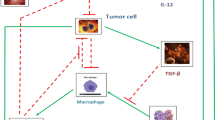Abstract
Modified T cells that have been engineered to recognize the CD19 surface marker have recently been shown to be very successful at treating acute lymphocytic leukemias. Here, we explore four previous approaches that have used ordinary differential equations to model this type of therapy, compare their properties, and modify the models to address their deficiencies. Although the four models treat the workings of the immune system in slightly different ways, they all predict that adoptive immunotherapy can be successful to move a patient from the large tumor fixed point to an equilibrium with little or no tumor.












Similar content being viewed by others
References
de Pillis L, Radunskaya AE (2006) Mixed immunotherapy and chemotherapy of tumors: modeling, appplications and biological interpretations. J Theor Biol 238:841–862
de Pillis L, Radunskaya AE, Wiseman CL (2005) A validated mathematical model of cell-mediated immune response to tumor growth. Cancer Res 65:7950–7958
Dong Y, Miyazaki R, Takeuchi Y (2014) Mathematical modeling on helper T cells in a tumor immune system. Discrete Continuous Dyn Syst B 19:55–71
Eshhar Z, Waks T, Gross G, Schindler DG (1993) Specific activation and targeting of cytotoxic lymphocytes through chimeric single chains consisting of antibody-binding domains and the \(\gamma \) or \(\zeta \) subunits of the immunoglobulin and T-cell receptors. Proc Natl Acad Sci 90:720–724
Grupp SA et al (2013) Chimeric antigen receptor-modified T cells for acute lymphoid leukemia. N Engl J Med 368:1509–1518
Janeway CA, Travers P, Walport M, Shlomicki MJ (2001) Immunobiology: the immune system in health and disease. Garland Publishing Company, New York
Kirschner D, Panetta JC (1998) Modeling immunotherapy of the tumor-immune interaction. J Math Biol 37:235–252
Kuznetsov VA, Makalkin IA, Taylor MA, Perleson AS (1994) Nonlinear dynamics of immunogenic tumors: parameter estimation and global bifurcation analysis. Bull Math Biol 56:295–321
Maude SL et al (2014) Chimeric antigen receptor T cells for sustained remission in leukemia. N Engl J Med 371:1507–1517
Mohri H et al (2001) Increased turnover of \(T\) lymphocytes in HIV-1 infection and its reduction by anti-viral therapy. J Exp Med 194(9):1277–1287
Moore HN, Li NK (2004) A mathematical model for chronic myelogenous leukemia (CML) and T cell interaction. J Theor Biol 227:513–523
Park TS, Rosenberg SA, Morgan RA (2011) Treating cancer with genetically engineered T cells. Trends Biotechnol 29:550–557
Acknowledgements
Funding was provided by National Science Foundation (Grant No. DMS 1505215).
Author information
Authors and Affiliations
Corresponding author
Rights and permissions
About this article
Cite this article
Talkington, A., Dantoin, C. & Durrett, R. Ordinary Differential Equation Models for Adoptive Immunotherapy. Bull Math Biol 80, 1059–1083 (2018). https://doi.org/10.1007/s11538-017-0263-8
Received:
Accepted:
Published:
Issue Date:
DOI: https://doi.org/10.1007/s11538-017-0263-8




